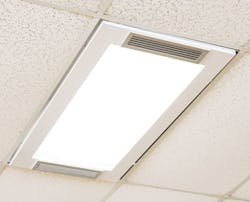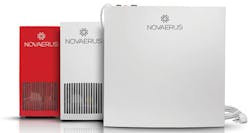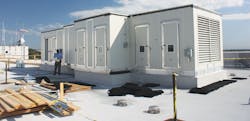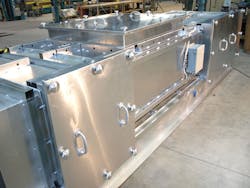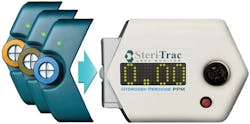Invisible invaders are almost always lurking in the air, ready to make people sick — or sicker. Airborne pathogens in the healthcare setting, Legionella, Aspergillus, influenza, to name a few, can increase a patient’s risk of developing healthcare associated infections (HAIs) and other problems, especially among those who already have weakened immunity.
“Several recent studies [also] show that pathogens like MRSA and C. Diff, long thought to be transmitted via contact, have been found isolated in air samples,”1-4 said Linda D. Lee, DrPH, MS, MBA, Executive Vice President, Chief Science Officer, VidaShield. “People, room air turbulence, patient belongings and healthcare activities in the room can cause those pathogens that have settled on to surfaces to become airborne and become a risk for both direct and indirect transmission.”
It’s no secret then that adopting effective products and protocols specifically designed to target and eliminate airborne pathogens is a vital component in a facility’s overall infection prevention strategy. Healthcare Purchasing News highlights some insights and solutions for keeping the air cleaner.
Kill ‘em with light
The use of ultraviolet technology to kill pathogens on hospital surfaces and in the air, is now a staple in the fight against infection for many healthcare facilities.
Nancy Fallwell, RN, director of Infection Prevention, Driscoll Children’s Hospital, Corpus Christi, said her facility was concerned about a persistent odor they couldn’t get rid of and while there were no outbreaks, they knew they needed to act. “As a children’s hospital, we serve some of the most vulnerable populations. We are also aware of the health and well-being of our staff and visitors to our facility,” said Fallwell. “We tried several approaches to clean the air. When they didn’t work, we looked to VidaShield. Airborne bacteria were reduced 86 percent. We know that contaminants can land on surfaces and be stirred up again by ordinary activity, so we were quite pleased to see the significant reduction. We are so happy we are installing more units in our facility. It’s a straightforward, cost-effective way to protect our patients, staff, and visitors.”
Lee says the Vidashield technology uses UV-C inside a shielded chamber that wipes out airborne pathogens all day, every day, even in occupied areas. “Because the unit can operate continuously, it enables the pathogens to make as many passes over the UV-C as necessary to neutralize the pathogen, returning treated air to the room after each pass,” Lee said. “In most cases, the intensity of the UV-C is enough to treat the air on the first pass. The air purification system has proven effective in ICU areas to reduce healthcare-associated odors, airborne bacteria and fungus in addition to bacteria and fungus that have settled onto surfaces in patient rooms, hallways and support areas. It is effective in reducing odors in soiled utility rooms in ORs.” VidaShield is seeking U.S.-based acute care hospital systems for several research initiatives. Call 888-208-7776 for more information.
David Kirschman, MD, President, Aerobiotix, explained how his company’s patented ultraviolet technology, which can be used in ORs, construction zones, ICUs, burn units, and central supply areas also reduces airborne pathogens.
“Our system uses a unique solid-state ultraviolet germicidal irradiation (UVGI) technology to inactivate pathogens,” Kirschman said. “Rather than use ultraviolet directly, we diffuse the energy through a solid volume of quartz tubes. The airstream percolates through the tubes, slowing down the microbes and creating a large inactivation surface. In independent testing, it eliminated 100 percent of viruses, 99.97 percent of bacteria, and 99.91 percent of spores in a single pass.”
Aerobiotix offers two models: The Illuvia, which operates from a wheeled cabinet requiring about 18 inches of space and a place to plug in and the Germzone upper wall mounted model which requires a simple surface installation, standard plug or optional hard-wiring. Both require regular cleaning and filter changes.
“Other systems which use UVGI to decontaminate air tend to blow the air directly past UV sources. This does not give adequate time for decontamination to occur, especially for hardy pathogens such as spores,” asserted Kirschman. “For our upper room systems, a key benefit over previous systems is that there is no exposure of the room occupants to UV. The system is fully internalized and fans power the airflow rather than using passive room currents.” Kirschman said the RTI Center for Microbial Community Systems and Health Research has validated the technology and that research showing up to 80 percent reductions in airborne bacterial levels in the OR will be published soon.
HVAC and more
Kassandra Keller, Senior Vice President, Business Development, Novaerus, says viruses such as norovirus and rhinovirus have a smaller particulate compared to other pathogens, making them more likely to become airborne and linger there longer. “Coughing, sneezing, flushing toilets and movement of linens all generate aerosols that can stay in the air for varying amounts of time and can easily be inhaled by those in the room,” Keller said. “With the increased focus on reducing readmissions and costs throughout the healthcare continuum, clean air is an indispensable part of a comprehensive infection prevention program.”
The Novaerus technology — available in stand-alone units and in-duct HVAC integration — is a filterless solution that operates using Dielectric Barrier Discharge (DBD) Plasma technology to inactivate viruses, bacteria, VOCs, spores, pollen, and allergens by drawing air into the unit and over the plasma field. “In contrast to filters which trap particulates, organic particles that interact with the Novaerus plasma field are rapidly ionized and oxidized rendering micro-organisms inert,” said Keller. “Tests conducted by third-party laboratories have shown that Novaerus plasma technology consistently provides 4-log reduction of viruses and 6-log reduction of bacteria. We have partnered with independent third party laboratories including the AMES laboratory of NASA, to clearly demonstrate the efficacy of our plasma technology. Field based testing and client data demonstrates real-world success including over 50 percent reduction in bio-burden and over 50 percent reduction in infection rates.
Another concern with air quality in health care facilities “is balancing the ever-increasing demands of the energy code with the demands and design implications of air filtration and air Quality,” said Bill Bullock, Director, Engineering, Environmental Air Systems (EAS), a custom HVAC solutions provider for the healthcare and pharmaceutical industries. “Introducing more outside/fresh air and using higher MERV [minimum efficiency reporting value] rated filtration ultimately drives up the energy consumption of the HVAC system. There are of course standards and guidelines for this; however most healthcare facility customers have their own perception of what is required.” Bullock says EAS air handling units are 100 percent wash down-capable, constructed from corrosion-resistant aluminum and stainless steel materials along with low-porosity polyurethane foam insulation which does not absorb water, unlike fiberglass insulation that can allow water to wick and mold to grow.
The LifeAire System, originally designed for use in laboratories where human embryos are cultured, is another air purification system that destroys airborne pathogens in areas where patients with compromised immunity are being cared for, including the OR. “The LifeAire System is an in-duct multi stage filtration/purification system that eliminates 99.9 percent of airborne pathogens via a genomically modeled UV irradiation chamber,” explained Michael Magee, Vice President, Sales and Business Development, LifeAire Systems LLC. “Proper installation requires the system to be engineered into the location’s HVAC ducting in such a way as to be properly sized for the volumetric space(s) that must be purified. To our knowledge the LifeAire System is the only patented device that provides remediation of three types of airborne contaminants in a single device (VOC’s, Biological pathogens and Particulates). LifeAire Systems also makes AirePathogen Alert for continuous monitoring and rapid detection of airborne pathogens such as bacteria, yeast and molds. “Identification of an issue is the first step toward a solution,” said Magee.
Maintaining good air quality in the sterile processing department, where continuous use of harsh sterilants and high-level disinfectants can harm worker health and safety, is another priority to consider. Exposure to low-temperature sterilants and high-level disinfectants can also occur in ORs and GI units/endoscopy rooms.
“These chemicals (Hydrogen Peroxide, Ethylene Oxide, and Peracetic Acid to name a few) can be very hazardous to workers if inhaled and each can cause a myriad of health effects,” said Richard Warburton, PhD, Chief Technical Officer, ChemDaq Inc. “The air around the equipment, exhaust system and chemical storage cabinets should be continuously monitored. Recently, Advanced Sterilization Products (ASP) released a study proving hydrogen peroxide (a colorless, odorless gas) sterilizers leak, exposing workers to these dangerous vapors without their knowledge.”5
ChemDAQ’s gas detection and monitoring solutions will detect and alert workers exposed to harmful vapors within seconds. “ChemDAQ provides both portable and fixed real-time monitors that allow air monitoring in specific areas of concern or as needed to check for leaks or malfunctions,” Warburton said. “Badging is commonly used to comply with OSHA standards on worker exposure to hazardous chemicals, but does not provide real-time protection for workers. They are designed to document time-weighted average (TWA) exposures after the exposure has already taken place and can take weeks to get results. ChemDAQ’s continuous monitoring devices give real-time results and provide an audible and visual warning the second exposure limits are exceeded. There are also other continuous monitors available for monitoring these chemicals, but they do not have the selectivity that ChemDAQ’s sensors provide. This means that the other monitors may show a spike in Ethylene Oxide concentration (for example) when there is no Ethylene Oxide in the room due to interference from other chemicals like alcohols or carbon monoxide. False alarms discredit the gas monitor and workers may not react when there are dangerous levels of chemicals present.”
Even the flooring in patient and other rooms, which may contain unhealthy chemicals and/or require harsh cleaning detergents and sealants, can poison air.
Tim Cole, Vice President, Marketing, nora systems Inc. says his company’s eco-friendly rubber flooring offers an alternative to traditional floor covering and that it’s also CA 01350-compliant and GREENGUARD Gold certified for low emissions. “nora premium rubber flooring is free of polyvinyl chloride (PVC) and does not contain plasticizers (phthalates) or halogens (e.g., chlorine),” Cole said. “The floor’s dense, nonporous surface helps repel bacteria, making the floor naturally resistant to bacteria, fungi and micro-organisms. Additionally, rubber flooring does not require stripping, recoating or the application of sealants. The absence of finishes and other chemicals benefits everyone in a healthcare setting, especially those who might be sensitive to smells or suffer from allergies that these products aggravate. It also means patients will not need to be moved and large areas of a facility closed for an extended period of time while floors are cleaned and coatings or finishes are applied and allowed to dry. This is especially important in busy healing facilities that operate around the clock.” The new nora pro steamer, which heats distilled water to more than 150° C., can be used to deep-clean the floors with no odors, reliance on harsh chemicals or disruption to patients.
References
1. Best, EL, Fawley, WN, Parnell P, Wilcox MH (2010) The potential for airborne dispersal of clostridium difficile from symptomatic patients, Clin Infect Dis 50(11):1450-7. doi:10.1086/652648
2. King, MF, Noakes, CJ, Sleigh, PA, Camargo-Valero, MA (2012) Bioaerosol deposition in single and two-bed hospital rooms: A numerical and experimental study. Building and Environment, 59:436-447
3. Mirhoseini, SH, Nikaeen, M, Shamsidadeh, Z, Khanahmad, H. (2016) Hospital air: A potential route for transmission of infections caused by -lactam—resistant bacteria, American Journal of Infection Control 44:898-904. doi:10.1016/j.ajic.2016.01.041
4. Hathway, EA, Noakes, CJ, Sleigh, PA, Fletcher, LA (2011) CFD simulation of airborne pathogen transport due to human activities. Building and Environment, 46 (12) 2500-2511
5. STERRAD Systems vs. STERIS V-PRO Hydrogen Peroxide Emissions Study, http://www.chemdaq.com/newsite/wp-content/uploads/2016/10/Comparison-Study-of-Environmental-Hydrogen-Peroxide-Levels.pdf
About the Author

Valerie J. Dimond
Managing Editor
Valerie J. Dimond was previously Managing Editor of Healthcare Purchasing News.

